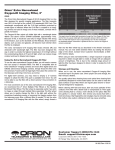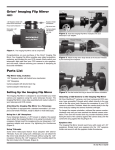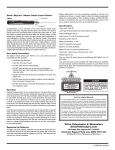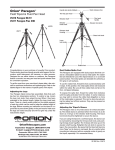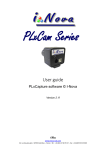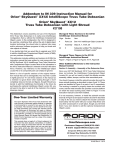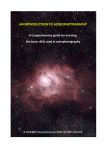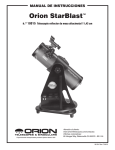Download Orion STAR SHOOT 52175 User's Manual
Transcript
instruction Manual Orion® StarShoot™ Solar System Color Imaging Camera IV #52175 Providing Exceptional Consumer Optical Products Since 1975 OrionTelescopes.com Customer Support (800) 676-1343 E-mail: [email protected] Corporate Offices (831) 763-7000 89 Hangar Way, Watsonville, CA 95076 © 2008-2010 Orion Telescopes & Binoculars IN 404 Rev. A 11/10 Welcome to a new world of adventure. Your new StarShoot Solar System Color Imaging Camera IV (SSSSI-IV) is capable of capturing detailed, fullcolor images of astro nomical objects in our solar system. The planets, Moon, Figure 1. To use the SSSSI-IV, a and Sun (with optional solar telescope, mount and computer are required. filter) can all be imaged to create spectacular views on your computer which can be saved for emailing or printing later. The SSSSI-IV can even be used during the day to take images of terrestrial subjects. You’ll find that this inexpensive, yet capable and easy to use, camera will enhance all of your journeys with your telescope. Please read this instruction manual before attempting to use the camera or install the needed software. For most types of astro-imaging with the SSSSI-IV, using a telescope with a focal length of at least 1000mm is recommended. Otherwise, the image scale may be too small. To increase the effective focal length of your system, use a Barlow lens or other type of tele-extender lens. Mount While using an equatorial (EQ) mount is recommended to achieve the best results, one is not absolutely required for imaging with the SSSSI-IV, as the maximum exposure time is only a fraction of a second, astronomical objects will not drift significantly through a telescope attached to an altazimuth mount or Dobsonian base during single image captures. Use a sturdy mount that is appropriately sized for the telescope tube being used. For obtaining the best planetary images, however, we do recommend an equatorial mount. Planetary imaging requires combining many individual images, and having an equatorial mount will prevent the planet from drifting out of the field of view of the camera during the time it takes to acquire the large number of images necessary. A motor drive (single-axis) is recommended too for convenient capture of sequential images without manual re-adjustment of the telescope’s position. Computer A computer is required for normal use of the SSSSI-IV. For astro-imaging in the field at night, a laptop computer is highly recommended. The camera driver and Orion Capture software requires Windows XP, Vista or 7. The following hardware is required: • Processor – Pentium III™ or equivalent, or higher Parts List • Recommended minimum memory size is 256 MB. • StarShoot Solar System Color Imaging Camera IV (SSSSI-IV) • USB Cable • Video Display – 800 X 600, 16-bit color or higher. 1024x768 or higher is recommended. • CD-ROM System Requirements • Mouse (external or built-in) (refer to Figure 1) Telescope The SSSSI-IV can be used with virtually any telescope that is compatible with 1.25" format eyepieces. The camera simply is inserted into a focuser in the same way as a standard eyepiece (Figure 1). If you use a star diagonal, you should remove it before installing the SSSSI-IV. If your telescope does not have enough inward focus travel, you will need to use an optional 1.25" Barlow lens to extend the telescope’s focal plane to the camera’s imaging plane (Barlow sold separately). 2 • Disk Space – 100 MB minimum, 500 MB or more recommended for saving images. • Internet connection required to display on-line help and downloading image processing software • High Speed USB 2.0 port Software and Driver Installation Before the camera can be used, image capture software and a camera driver must be installed onto your computer. Turn on your computer and allow the Windows operating system to load as normal. Insert the included CD-ROM into your computer’s CD-ROM drive, and the Launcher will appear (Figure 3 8. Wait a few moments and the camera will automatically install on your computer. When Device Installed Successfully notification appears you will be ready to use the camera. 2). This allows you to install the Orion StarShoot Solar System Imager camera driver and the Orion image capture software (Orion AmCap). Camera Driver Installation Do not connect the SSSSI-IV to your computer yet. 1. Insert the CD-ROM into the drive. The Launcher will appear. If you are using Windows Vista, the AutoPlay window will appear first. Select Run autorun.exe. 2. Click Install Camera Driver. 9. Open Orion AmCap from the icon on your desktop. The Live Video Window should appear (Figure 4). The software will recognize many cameras so check that D-PEN is selected from the device menu. Figure 2. The launcher provides an easy menu for software installation. 3. The D-PEN Software Installation will start. Once the driver is installed, the computer will recognize the SSSSI-IV whenever it is plugged in. Figure 3. When initially connecting the SSSSI-IV to a computer, a Found New Hardware notification will appear and automatically install the camera to your computer. Capture Software Installation Now that the camera driver software is installed, the capture software must also be installed. 1. Return to the Launcher and click Install Capture Software. 2. The Orion AmCap Setup Wizard appears. Click Next. 3. Select a destination folder and Click Next. 4. Click Next again to start the installation. 5. When the wizard is complete, click close. This has installed the capture software. 6. Plug in the camera into your computer’s USB port. 7. A Found New Hardware notification will appear in your Windows task bar (Figure 3). The found new hardware wizard will launch. Select next. Select install the software automatically. Select next. Select Continue Anyway and the hardware wizard will begin Installation. 4 Image Processing Software Website links are provided in the launcher to download popular free Image processing software to be used with your AVI files to enhance your astro Images. 4. You are now ready to install. Click Install. The installation will proceed. 5. When installation is complete click the Finish button. Figure 4. The live video window. Image Processing Software such as RegiStax or AviStack; can Align and Stack(combine) hundreds of individual images into a single resultant image and perform some additional image processing to bring out subtle details or to make the image appear more pleasing overall. Image Processing Software Installation Return to the launcher and select RegiStax or AviStack to be directed to a website to download the latest software. For detailed information on the image processing software consult the websites of each software provider. Tutorials and user groups can be found online also. Getting Started During Daylight We recommend using the SSSSI-IV for the first time during the day. This way, you can become familiar with the camera and its functions without having to stumble around in the dark. Set up your telescope and mount so the optical tube is pointing at an object at least a couple of hundred feet away. Insert an eyepiece and focus as you normally would. To obtain first images with the SSSSI-IV, follow these step-by-step instructions: 1. Plug the camera into your computer’s USB port. Notice the red LED shining through the blue window on the back of the camera; this LED light indicates the camera is connected and receiving power from the computer. 5 7. Look at the Live Video Window on the computer screen and adjust the focus knob accordingly to determine best image focus. 2. Double click the Orion AmCap icon now installed on your computer’s desktop. Note: The camera’s field of view is fairly small. It is approximately equivalent to the field of view through the telescope when looking through a typical (i.e. not wide-field) 5mm focal length eyepiece. 3. Orion AmCap will automatically connect directly to your camera with a Live Video Window. Your Live Video Window will only show light and dark before the camera is coupled to your telescope. 4. When the camera is connected to the computer, the Live Video Window (and subsequent images captured with the camera) will display at 640x480 resolution. To change to full resolution mode, select Video Capture Pin from Options menu, select 1280x1024 under the Output Size heading, then click OK (Figure 5). The Live Video Window will now display at full resolution, and will occupy most of the computer monitor’s screen. Any images captured with the camera will now also be at full resolution. To move the Live Video Window out of the way, click on the top bar of the window and drag it to the desired location on the computer screen. 5. To connect the camera to the telescope, simply replace the telescope’s 1.25" eyepiece with the camera. Make sure the securing thumbscrew on the focuser drawtube is tightened after the camera is inserted. Figure 5. Changing resolution via options->Video Capture Pin. 9. Select Capture File from the File menu and name your file including the AVI extension name. IE mymovie.avi. Click Open. 10. Enter the amount of disk space to allocate as a buffer for this data. Movie files need a large amount of disk space. Enter a value such as 50 Megabytes or higher. Press ok. The size of the captured data may be much higher than this value depending upon number and size of frames captured. 11. Select Set Frame Rate under the Capture menu. Check the box Use Frame Rate and type 15. Press ok. 12. Select Set Time Limit under the Capture menu. Check the box Use Time Limit and type 20. Press ok. 13. Select Start Capture under the Capture menu. 14. Press ok when you are ready to capture Images. An AVI movie sequence of 300 frames (15 frames per second x 20 seconds) will now be recorded. The total number of captured frames is displayed on the bottom bar. If frames are being dropped this will be displayed and the frame rate or resolution should be set to a lower value to prevent this. Figure 6. Changing exposure via options->Video Capture Filter. 6. You will now need to refocus the camera for the centered object. Focusing will be the hardest thing to learn in the initial stages. If you are starting out in daylight, as is recommended, you may need to turn the exposure and/or brightness control of the camera down before attempting to focus. This is done by selecting Video Capture Filter in the Options menu and moving the exposure or brightness slider (Figure 6). If the daytime image brightness is still too bright to produce an acceptable image on your computer screen, you may need to stop-down the aperture of your telescope. 6 8. Image orientation can be changed by rotating the camera within the focuser drawtube. Simply loosen the thumbscrew on the drawtube and rotate the camera until the desired image orientation is achieved. Retighten the thumbscrew on the focuser drawtube when done. You may need to slightly refocus (using the telescope’s focus knob) if the focuser drawtube has moved a bit inward or outward when the camera was rotated. You have now taken your first images with the SSSSI-IV! This simple method of imaging is exactly how the camera is used to capture terrestrial subjects during daylight hours. Close-up images of birds and other wildlife or faraway vistas can all be obtained in this way with the SSSSI-IV. Solar images can also be taken during the day with an optional full-aperture solar filter over the front of the telescope. Take some time to use the camera and Orion AmCap software during the day to become familiar and comfortable with their basic operation. For best results, you can optimize your images with the camera controls. 7 Camera Controls For best images, you can adjust the camera controls though Orion AmCap to fine tune the image. You can see how the camera controls affect an image in the Live Video Window. From the Options menu choose Video Capture Filter and you can access the camera controls. Here you will find the Brightness, Contrast, Gamma, Hue, Saturation (level of color), Sharpness (keep this low as it can add noise), and Exposure controls. The Exposure control is a gain adjustment that allows additional flexibility in adjusting image brightness. You can manually adjust this by moving the slider. To return the camera controls to their default settings, click the Default button. The other camera controls are available by selecting Video Capture Pin from the Options menu. This accesses the Stream Format property sheet, which allows you to set additional parameters. The Frame Rate, while generally should be left at 15 frames/second for the sharpest planetary images, can be toggled down to 7.5 frames/second for brightest exposures. This value may be overridden If the use Frame Rate box Is checked in the Capture -> Set Frame Rate menu. (You can also use the Video Capture Filter selection described previously to adjust image brightness.) Check the Flip Horizontal box to change the orientation of the image display in the Live Video Window. The Output Size can be used to shrink the image size if desired; the camera defaults to 640x480, but you should raise this to the highest setting (1280 x 1024) for the maximum possible resolution. Try several different settings to get a feel of how the camera controls work and affect the resultant image on the computer screen. The Brightness and Exposure controls are the ones you will use the most. The telescope being used, seeing conditions, and object being imaged will dictate how these camera controls should be set. Usually Exposure will be set first, then Brightness is adjusted as needed. Astronomical Imaging Now that you’re familiar with basic camera and software operation, it’s time to take the SSSSI-IV out at night under the stars to capture some astronomical images. We recommend starting with the Moon, as it is easy to acquire into the camera’s field of view, and typically does not require stacking of multiple exposures as planetary images do. Imaging the Moon Imaging the Moon is much like imaging terrestrial objects during the day. Since the exposure is very short, it is not critical that the telescope be precisely polar aligned. 8 When the moon is past half full, it is hard to get detail due to the tremendous glare off of the lunar surface. Most detail, even on a sliver of a moon, will be at the terminator (that tiny thin line between the shadow and light, see Figure 7). To get more of the moon in the image, a focal reducer will need to be used. For close-ups of craters use a Barlow lens (see “Using Focal Reducers and Barlow Lenses”). Figure 7. The moon’s surface detail looks the best along the terminator. Imaging Planets The best planetary images will be obtained by stacking (combining) many individual images in order to improve image contrast, brightness, and detail. A great way to obtain images for stacking is to take several seconds of video of the planet, then break the video into individual frames for stacking. Since the SSSSI-IV has a maximum frame rate of 15 frames per second at maximum resolution, you can literally obtain hundreds of images for stacking in seconds! You save time by taking one video instead of dozens of individual pictures! Figure 8. Jupiter with Ganymede and shadow in transit. Left. Live image Right. 500 frames Aligned, stacked and enhanced using Registax Image Processing Software. Image taken with Orion 180mm Mak-Cass telescope. Since you will be taking multiple images over a period of time, it is important you have a decent polar alignment in order to keep the planet within the field of view of the camera. To this end, having a motor drive (at least single-axis) will also be helpful. Otherwise, you will periodically need to rotate the R.A. slowmotion knob to keep the planet within the camera’s field. Tips Focusing One of the hardest things to do in planetary imaging is achieving good focus. You can make this process easier by simply watching the Live Video window to focus. Depending upon the viewing conditions you may notice that the image goes in and out of focus, this is due to viewing conditions. This is to be expected and one of the reasons why post processing software can bring out the best in your captured images. Focus as best as possible with the average frame being at best focus to ensure more in focus frames than out of focus. 9 Image processing software can then be used to select the best frames to combine for best results and can also reject the poorest frames. Refocus often throughout your imaging session. This ensures at least some of your images will have an excellent focus. It is also not uncommon for telescope movements to alter the focus slightly, so be sure to refocus for any new astro-imaging targets. Choosing a Site for Astro-imaging Once you have a focused image, you may find your image shifting and washed out. This can be caused by many environmental factors. Poor seeing (movement of molecules in the air, such as heat rising) and poor transparency (moisture, smoke, or other sky contaminants) will all serve to reduce image quality. That is why most major astronomical telescopes are on high mountains in thin air, to get above much of the seeing and transparency problems. Also, wind will move your telescope and affect images. Your eyes viewing through an eyepiece can change slightly to compensate for disturbances like these, but the camera cannot. Keep these factors in mind when choosing an observing site for astronomical imaging. For the best astro-images, we recommend finding a location with dry air, some altitude, and away from city or streetlights. Even a nearby hilltop in the countryside can provide better viewing conditions than many convenient backyard locations. Loss of Camera Connection If the computer connection to the camera is interrupted, you will need to re-establish connection. This can happen due to several reasons; if a cable becomes unplugged, the computer “freezes”, or the software/hardware otherwise temporarily loses the data coming from the camera. To re-establish camera connection, first close the Orion AmCap program on your computer. Then, unplug and re-plug the camera into the computer’s USB port. Now, open Orion AmCap, and the Live Video Window should appear indicating re-established connection between camera and computer. Using Focal Reducers and Barlow Lenses Focal reducers serve to decrease the focal length of your telescope. This increases the field of view seen by the camera (decreases camera magnification). This can be useful for obtaining images of wider objects, such as the full Moon or a landscape vista. Barlow lenses, or other tele-extenders, increase the focal length of your telescope, which makes the camera field of view narrower (increases camera magnification). This is useful for high-power planetary images. Keep in mind that when the focal length is doubled, the image will become four times dimmer, so a longer exposure may be necessary. 10 For best planetary imaging, you should shoot with an effective focal ratio (telescope focal length ÷ telescope aperture) of F/20 or greater. This will give you a good combination of image brightness and image scale for planets. For most telescopes, a Barlow lens will be required to obtain this focal ratio. For example, Schmidt-Cassegrain telescopes usually have a focal ratio of F/10. A 2x Barlow lens doubles the effective focal length of the telescope, which makes the focal ratio f/20. Similarly, a 3x Barlow lens will yield of focal ratio of F/30. You can also try using multiple Barlows to obtain even greater effective focal ratios. There is a limit to how large a focal ratio your telescope and seeing conditions can handle, however. Experimentation will be needed to see what your telescope is capable of in the seeing conditions on a given night. If the image appears somewhat dim and fuzzy on the computer screen, you may want to consider removing the Barlow lens. (Focal Reducers and Barlow lenses available through Orion, check the catalog or OrionTelescopes.com for more information). Filters For some types of planetary imaging, you may want to use color filters to bring out subtle details. Any standard Orion 1.25" filter will thread into the front of the SSSSI-IV’s barrel. Try using different color filters on a planet to see which filters help best show planetary details. Neutral-density Moon filters and variable-polarizer filters are useful to reduce the glare from the moon. They can also be used to reduce the glare from Venus. Solar Filter Warning: Always use a full aperture solar filter when viewing the sun. With a properly fitting full-aperture solar filter attached to your telescope, you can use the SSSSI-IV to take images of the Sun and the sunspots on its surface. (Filters available through Orion, check the catalog or OrionTelescopes.com for more information). Flip Mirror As easy as flipping a switch, the Imaging Flip Mirror enables the astrophotographer to find, center and focus a target visually with a 1.25" telescope eyepiece, then photograph it with a CCD camera. All without swapping out any equipment. It’s a real timer saver, making the normally tedious task of focusing with the CCD camera alone easier and quicker. (Available through Orion, check the catalog or OrionTelescopes.com for more information). 11 USB Extension Cable In many instances, it is likely that a longer cable for the SSSSI-IV will be needed in order to comfortably setup telescope, camera, and computer. We recommend purchasing a 10' USB extension cable if you need more cord length (available through Orion, check the catalog or OrionTelescopes.com for more information). Recommended Reading Things to Do Moon Learn your way around our closest celestial neighbor. • Image the craters, mountains and valleys. • Image the different phases from New moon to Full Moon (Books available through Orion, check the catalog or OrionTelescopes.com for more information). Figure 9. Use software to assemble individual frames to create a higher resolution image. Image taken using Orion Apex 90mm MakCass telescope and Orion 0.5x Focal reducer. 4 Individual images assembled In Adobe Photoshop. Specifications Sensor Micron Color CMOS sensor Sensor size 1/3" Number of pixels 1280 x 1024 pixel layout; 1.3 megapixel resolution • Image the detail at the terminator Pixel size 3.6µm x 3.6µm • Create a moon mosaic (Figure 9) Video frame rate Up to 15 frames/second at full resolution A/D conversion 8 bit IR filter Yes Connection High Speed USB 2.0 Barrel 1.25" threaded for filters Planets • Take a movie of the position of the great red spot of Jupiter during the Gas Giant’s <10 hour day. • Image Jupiter’s moons and their shadows as they transit across the Gas Giant Figure 10. Image taken using Orion Apex 90mm Mak-Cass telescope and Orion 0.5x Focal reducer. • Follow in Galileo’s footsteps by Imaging the different phases of Venus Solar • Using a full aperture Solar Filter to image sunspots (Figure 10) Terrestrial • Image wildlife from a far distance so as not to disturb feeding and nesting spots (Figure 11) 12 Figure 11. Small bird of prey. Image taken using Orion Apex 90mm MakCass telescope. 13 This device complies with Part 15 of the FCC Rules. Operation is subject to the following two conditions: (1) this device may not cause harmful interference, and (2) this device must accept any interference received, including interference that may cause undesired operation. Changes of modifications not expressly approved by the party responsible for compliance could void the user’s authority to operate the equipment. Note: This equipment has been tested and found to comply with the limits for a Class B digital device, pursuant to Part 15 of the FCC Rules. These limits are designed to provide reasonable protection against harmful interference in a residential installation. This equipment generates, uses and can radiate radio frequency energy and, if not installed and used in accordance with the instructions, may cause harmful interference to radio communications. However, there is no guarantee that interference will not occur in a particular installation. If this equipment does cause harmful interference to radio or television reception, which can be determined by turning the equipment off and on, the user is encouraged to try to correct the interference by one or more of the following measures: Reorient or relocate the receiving antenna. Increase the separation between the equipment and receiver. Connect the equipment into an output on a circuit different from that to which the receiver in connected. Consult the dealer or an experienced radio/TV technician for help. A shielded cable must be used when connecting a peripheral to the serial ports. One-Year Limited Warranty This Orion StarShoot Solar System Color Imaging Camera IV is warranted against defects in materials or workmanship for a period of one year from the date of purchase. This warranty is for the benefit of the original retail purchaser only. During this warranty period Orion Telescopes & Binoculars will repair or replace, at Orion’s option, any warranted instrument that proves to be defective, provided it is returned postage paid to: Orion Warranty Repair, 89 Hangar Way, Watsonville, CA 95076. If the product is not registered, proof of purchase (such as a copy of the original invoice) is required. This warranty does not apply if, in Orion’s judgment, the instrument has been abused, mishandled, or modified, nor does it apply to normal wear and tear. This warranty gives you specific legal rights, and you may also have other rights, which vary from state to state. For further warranty service information, contact: Customer Service Department, Orion Telescopes & Binoculars, 89 Hangar Way, Watsonville, CA 95076; (800) 676-1343. OrionTelescopes.com 89 Hangar Way, Watsonville, CA 95076 Customer Support Help Line (800) 676-1343 © 2008-2010 Orion Telescopes & Binoculars












